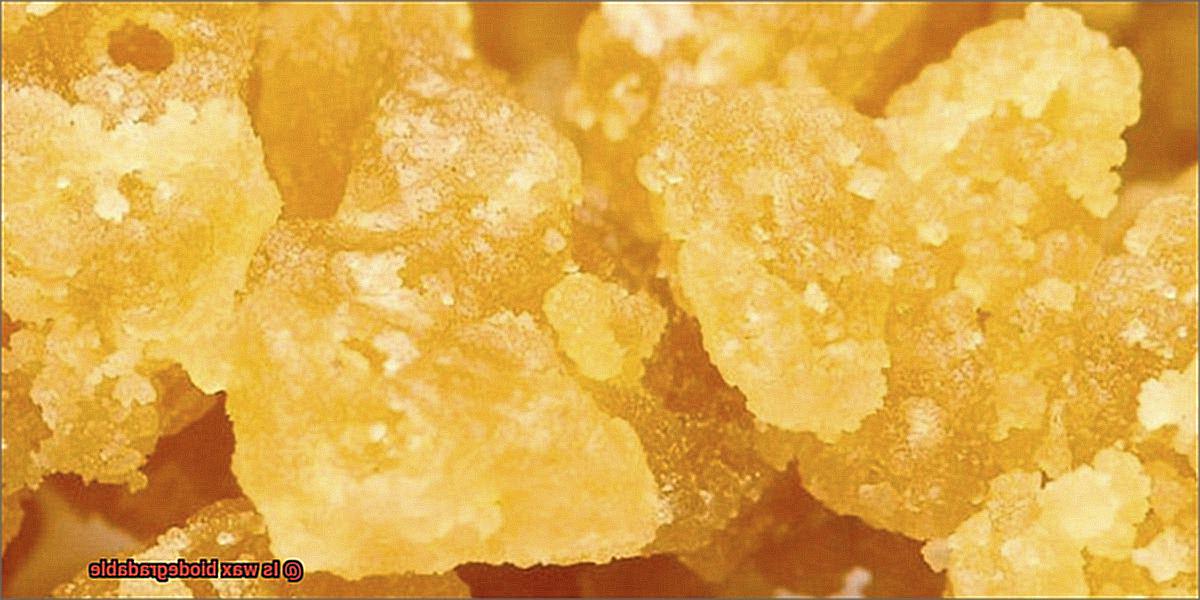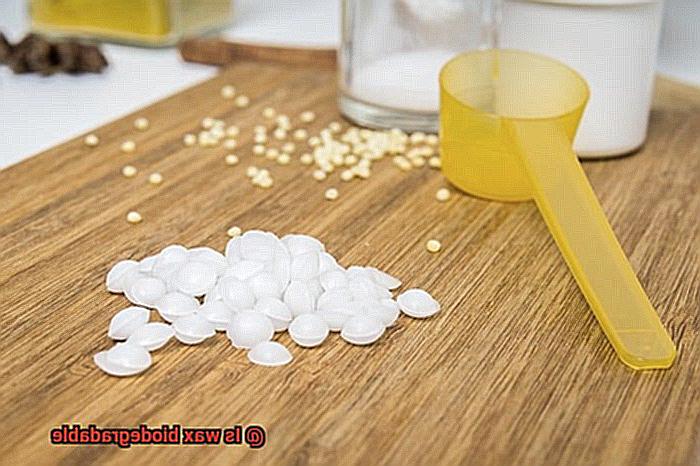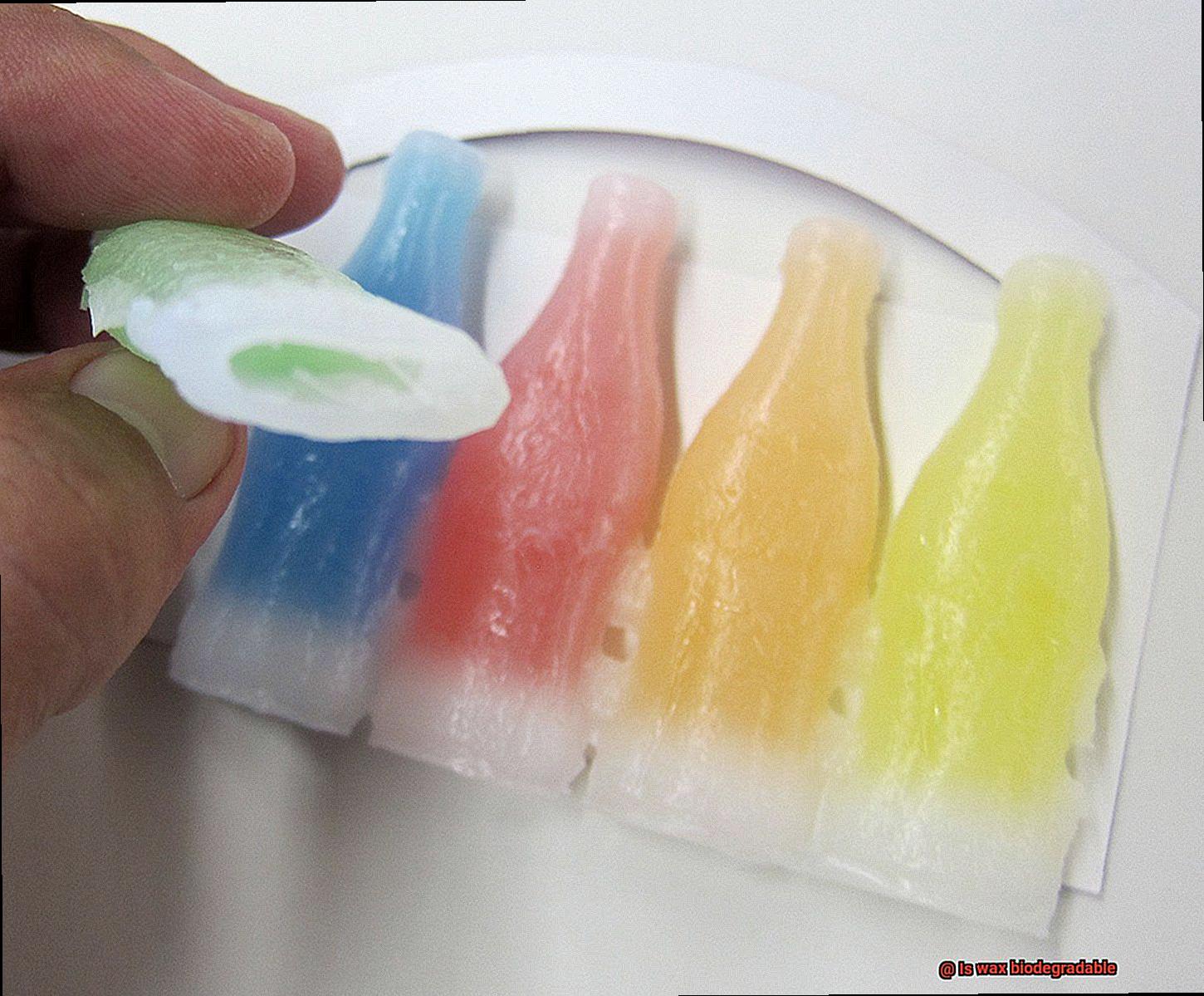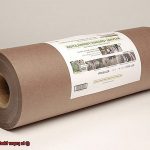Wax is an incredibly versatile and ubiquitous material that we come across in our daily lives. It finds its way into our candles, cosmetics, food packaging, and even our surfboards. But have you ever paused to think about what happens to wax once we’re done with it? Specifically, is wax biodegradable or does it persist in the environment indefinitely? This issue is gaining increasing attention in the media as concerns about plastic pollution grow.
The question of whether or not wax is biodegradable depends on its chemical composition. Wax generally consists of long-chain hydrocarbons, making it an organic compound. Organic compounds can typically break down over time through biodegradation. However, some organic compounds can take years or even centuries to decompose in the environment.
So, is wax biodegradable or not? The answer isn’t straightforward since there are many different types of wax, each with its unique properties and biodegradability. In this blog post, we’ll delve into the various types of wax, explore their capacity for biodegradation and discuss their implications for the environment. From beeswax to paraffin, soy wax to carnauba wax, we’ll take a comprehensive look at this fascinating and important topic.
a. Definition of Biodegradability
Contents
Essentially, if a material is biodegradable, it can break down and return to nature without causing any harm or leaving behind any toxic residues.
It’s important to note that not all materials are created equal when it comes to biodegradability. Some materials can take several years to fully decompose, while others may take only a few months. Additionally, some biodegradable materials may release harmful toxins during the decomposition process, which can negate their positive impact on the environment.
Plastics and synthetic fibers are notorious for taking hundreds or even thousands of years to break down, causing significant harm to the environment and wildlife. Therefore, it is crucial to choose materials that are biodegradable whenever possible to reduce our impact on the planet.
When it comes to wax, its biodegradability largely depends on its composition. Natural waxes like beeswax and soy wax are biodegradable and can break down naturally over time. However, some synthetic waxes contain chemicals that hinder their ability to biodegrade properly. It’s always a good idea to check the ingredients list of any wax product you use to determine its level of biodegradability.
It’s worth noting that even natural waxes may have a negative impact on the environment. For example, beeswax production requires land and resources which may contribute to deforestation and habitat loss for wildlife. Similarly, the manufacturing process of soy wax may involve the use of chemicals that can harm the environment.
In conclusion, understanding the definition of biodegradability is crucial in making informed choices about the materials we use in our daily lives. By choosing biodegradable materials whenever possible, we can help reduce our impact on the environment and promote sustainable living. The next time you’re shopping for candles or other wax products, be sure to check the ingredients list and choose natural waxes that are kinder to the environment.
Types of Waxes
Let’s start with petroleum-based wax. This type of wax, derived from crude oil, is widely used due to its low cost and ease of production. However, it’s not biodegradable and can take hundreds of years to decompose in our environment – yikes.

On the other hand, natural waxes derived from plants, animals, or insects are typically biodegradable and can break down quickly in the environment. Beeswax is a popular example of a natural wax used in cosmetics and candles. It’s not only biodegradable but also offers nourishing benefits for the skin.
If you’re looking for an eco-friendlier option, soy wax made from soybeans is renewable and biodegradable. It’s becoming increasingly popular as a sustainable alternative to petroleum-based waxes.

But wait, there’s more. Synthetic waxes made from chemicals are not biodegradable at all. That’s why it’s important to check the ingredients list of any wax product you use to determine its level of biodegradability.
Paraffin Wax
Paraffin wax, a cheap and commonly used wax, is not a sustainable choice.
Derived from petroleum, paraffin wax is not biodegradable and can take many years to break down when disposed of. This means that it can contribute to pollution and harm our environment. In addition, the production of paraffin wax can have negative environmental impacts, including air and water pollution and contributing to climate change through greenhouse gas emissions.
But there’s good news. There are better alternatives out there. Soy wax and beeswax are both natural and renewable resources that are biodegradable. These waxes are becoming increasingly popular among eco-conscious consumers who want to reduce their environmental impact.
When it comes to making sustainable choices, it’s important to check the ingredients list and opt for natural or renewable options like soy wax and beeswax. Not only are these waxes eco-friendly, but they also burn cleaner and longer than paraffin wax.
By choosing more sustainable waxes, we can still enjoy our candles and other products while also being kind to the environment. Remember, small changes can make a big impact. So next time you’re shopping for candles or other products that contain wax, choose wisely and opt for a more sustainable choice like soy or beeswax.
Beeswax
If you’re looking for a natural, sustainable wax option, beeswax might be just what you need. This natural wax is produced by bees and has a range of uses, from cosmetics to candles and food packaging. But what makes beeswax such a fantastic choice for the environment?
For starters, beeswax is biodegradable. This means that it can break down naturally over time without harming the environment. While the rate of degradation depends on environmental factors like temperature and humidity, one thing is certain: beeswax won’t clog up landfills for years on end.
What’s more, when beeswax degrades, it doesn’t release harmful chemicals or pollutants into the environment. Unlike synthetic waxes derived from petroleum, beeswax is an eco-friendly option that won’t harm the planet.
However, not all beeswax products are created equal. Some companies may use unsustainable harvesting methods or add synthetic ingredients that can harm bee populations. To ensure that you’re using ethically sourced beeswax, it’s essential to research the manufacturing process and source of any beeswax products you purchase.
But why choose beeswax over other sustainable wax options like soy wax? For one thing, beeswax has a natural honey scent that many people find appealing. It also has a longer burn time than some other waxes, making it an excellent choice for candles.
By choosing sustainable and ethically sourced beeswax products, you’re not only supporting a more eco-friendly industry but also helping to protect vital bee populations that play a crucial role in pollinating plants and crops.
Soy Wax
Soy wax is a biodegradable, renewable resource made from soybean oil, grown locally in the United States. By choosing soy wax, you’re not only supporting local farmers, but also making a sustainable and eco-friendly choice.
But that’s not all – soy wax candles offer numerous benefits over traditional paraffin wax candles. When burned, soy wax candles produce less soot and harmful chemicals than paraffin wax candles, making them a healthier option for both you and the environment. Additionally, soy wax burns at a lower temperature, which means that your candles will last longer too.
However, it’s important to dispose of soy wax responsibly to ensure its biodegradability. If not disposed of properly, soy wax may not break down as easily or quickly as it would if composted. So make sure to take an environmentally responsible approach when disposing of your soy wax candles.
In conclusion, switching to soy wax candles is an excellent way to make a positive impact on the environment and your health. By choosing this renewable resource, you’re supporting local farmers and reducing your carbon footprint. Plus, with cleaner burning and longer lasting candles, you can enjoy the benefits of soy wax without sacrificing quality or ambiance.
Is Paraffin Wax Biodegradable?
If you’re an environmentally conscious consumer, you might be wondering if paraffin wax is biodegradable. Well, the answer is yes, but with some major caveats.
Paraffin wax is a popular ingredient in many household products, including candles, crayons, and food packaging. It’s derived from petroleum and undergoes a refining process that results in a white, odorless, and tasteless wax. However, this refining process releases harmful chemicals into the air and water, contributing to pollution and climate change.
While paraffin wax is technically biodegradable, it can take years to decompose fully. So if you’re looking for a quick breakdown time for your candle or other product, paraffin wax may not be the best choice.
But don’t despair. There are more sustainable alternatives available. Soy wax and beeswax are great options for eco-friendly products because they are biodegradable and have a lower carbon footprint than paraffin wax. Plus, they last longer and support local farmers.
Ultimately, choosing soy or beeswax candles or other products over paraffin wax can make a significant impact on reducing your environmental footprint.
Is Beeswax Biodegradable?
Beeswax is a marvel of nature, produced by industrious honey bees in their hives. It has a myriad of uses, from cosmetics to food and pharmaceuticals. But the crucial question is, can beeswax be biodegradable? The short answer is yes, but there are some essential factors to consider.
The purity of beeswax is key to determining its biodegradability. If it has been treated with additives or chemicals, it may not break down naturally. Therefore, it’s vital to purchase pure, natural beeswax from reputable sources to ensure its biodegradability.
Moreover, the conditions under which beeswax decomposes can affect its biodegradability. If buried in a landfill with little oxygen or sunlight, it could take hundreds of years to decompose fully. That’s why proper disposal is crucial to ensure its biodegradability.
One eco-friendly way to dispose of beeswax is by composting it with other organic materials. Under the right conditions, such as in a home composting system, beeswax can break down within a few months. This not only ensures responsible disposal but also provides nutrient-rich soil for plants.
Beeswax’s natural biodegradability makes it an excellent alternative to synthetic waxes and plastics. By choosing natural beeswax products and responsibly disposing of them, we can reduce our environmental impact and promote sustainability.
Is Soy Wax Biodegradable?
Look no further than soy wax. This type of wax is made from soybeans, which are a renewable resource and biodegradable. Soy wax breaks down naturally over time, meaning it won’t contribute to environmental pollution.
But why is soy wax biodegradable? Well, it’s all thanks to its natural components that can decompose. When you dispose of soy wax, it will break down into its natural components and be absorbed back into the environment. This process can take anywhere from a few weeks to several months, depending on the conditions in which the wax is exposed.
Not only is soy wax biodegradable, but it’s also a cleaner-burning option than traditional waxes like paraffin wax. Soy wax produces less soot, which can contribute to indoor air pollution and be harmful to human health. Plus, soy wax has a lower melting point than paraffin wax, making it burn cooler and last longer.
And there’s more good news: soy wax is also a renewable resource. Soybeans are grown on farms and can be replanted each year, ensuring a sustainable supply of soy wax. This is in contrast to petroleum-based waxes like paraffin wax, which are derived from non-renewable resources.

It’s important to note that not all soy waxes are created equal. Some may contain additives or chemicals that could impact their biodegradability or eco-friendliness. So when choosing a soy wax product, make sure you look for one that is 100% natural and free from harmful additives.
Environmental Impact of Natural Wax Production
Because natural waxes are biodegradable and do not release harmful chemicals into the environment. However, it’s important to note that the production of natural waxes still has some environmental impact.
One major concern is the impact on habitats and ecosystems. For example, beeswax – a popular natural wax used in many products – is obtained by harvesting bees’ hives. Over-harvesting can lead to a decline in bee populations and disrupt entire ecosystems. Similarly, other natural waxes like soy wax require large amounts of land to grow the crops needed for production, leading to deforestation and habitat destruction.
But there are ways to minimize these impacts. For instance, sourcing natural waxes locally is a great way to reduce transportation emissions from vehicles. Additionally, alternative transportation methods like trains or ships can also help lower emissions.
So next time you’re shopping for candles or wax-based products, look for those made with 100% natural soy wax or other biodegradable waxes. By doing so, you’ll be doing your part in saving the environment while still enjoying all the benefits of high-quality natural wax products.
wt32GgQGTcI” >
Conclusion
To sum up, whether wax is biodegradable or not depends on its type and composition. Natural waxes such as beeswax and soy wax can biodegrade over time, while synthetic waxes made from chemicals may not. However, natural waxes also have their environmental impact, such as the land and resources required for beeswax production or the chemicals used in soy wax manufacturing.
Therefore, it’s essential to make informed decisions about the materials we use daily. Choosing biodegradable options can help reduce our ecological footprint and promote sustainable living.
When buying wax products, always check the ingredients list to determine their level of biodegradability. Natural waxes like beeswax and soy wax are eco-friendly alternatives to synthetic waxes like paraffin wax derived from petroleum that takes hundreds of years to decompose fully.





